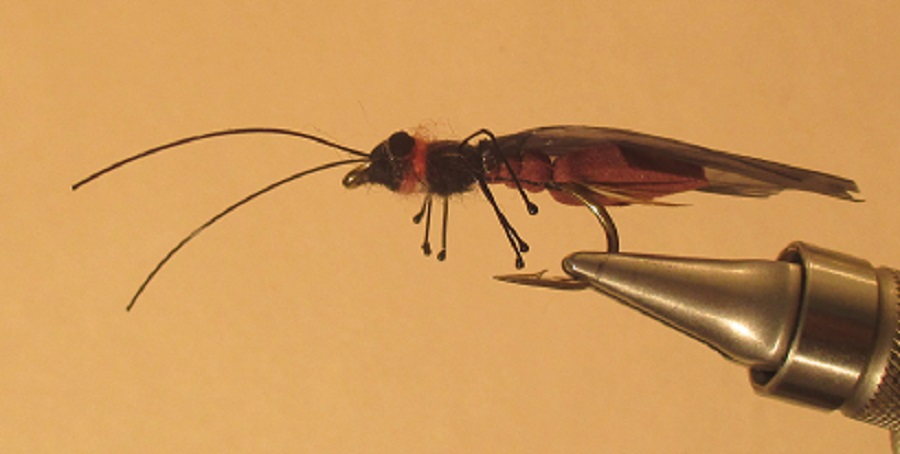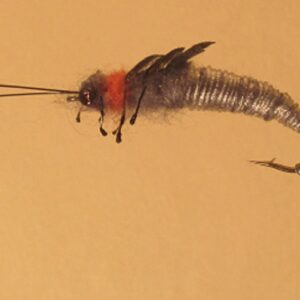Hook Size: 4|6
These large stoneflies do lay their eggs during the daytime as well as in the evenings.
This makes for some exciting dry fly fishing. Once you begin to observe the large
Salmonflies depositing their eggs you should try imitating them. You can cast the large
imitations in the fast water of the runs and riffles and at some point in time, the trout will
begin to take them even if they get swept under by the turbulent waters. When the trout
sees the females depositing their eggs, their wings are not necessarily folded down on
their bodies. They may be fluttering just above the surface to keep from falling in the
water, or the fly may have fallen into the water and the wings could be in a spent position.
Some anglers prefer to use a spent wing pattern of the adult.Notice that if you look closely at the top of the adult Salmonfly, you get an entirely
different view. It is much darker brown and the only salmon color is a small area around
the neck of the fly. When the Salmonflies are hatching, you can always find their shucks
along the banks. This is true of any stonefly hatch. If you examine the bushes along the
banks of the stream you will most always be able to find the adults. They live a relatively
long time out of the water and are easy to spot due to their large size. In fact, if the hatch
is prolific the bushes will be loaded with the large stoneflies. It makes you wonder just how
many were eaten by trout trying to get to the banks to hatch. If many of them made it
safely, most likely many didn’t make it; however, this can be a problem. The trout can
become gorged feeding on the huge nymphs. It may be some time later before the trout
are interested in eating the egg laying adults which are much more difficult for the trout to
catch than the nymphs.
The females usually don’t start depositing their eggs until a few days after the hatch first
starts. Just because you see a large number of stoneflies in the bushes and air, doesn’t
mean that imitating them will be effective. You also have to consider the fact that the trout
may be full of the stonefly nymphs and will not begin to actively feed for a while. If you are
seeing a lot of adult stoneflies and you are not catching trout on dry fly imitations of them,
most likely you are fishing a little early in the process. Either move a few miles
downstream where the hatch may have started earlier or wait a day or two to try again. At
some point in time the trout will begin to take them.
Presentation:
The large dry fly imitations of the adults can be a little difficult to cast, especially in wind
which is usually blowing strongly. We suggest at least a 5 weight, medium fast to fast tip
rod of nine feet length. A 6 weight may be a better choice. We use almost every cast in
the book to present the fly -upstream, cross-stream and downstream. If you see a trout
take an egg layer or attempting to do so, it is of course, a good idea to cast to it but most
of the time you are blind casting.
Some angler try to impart some action to their fly. We don’t because we usually scare
more trout than we fool. We think a dead drift is best even though you will see the real
ones fluttering over and even on the surface of the water. Unless we see trout taking flies
in a particular part of the stream, we make upstream and slightly up and across cast
along the banks of the stream. It is tempting to make long cast but you will usually end up
missing some fish if you cast too far. You’ll see some guys act as if they are in a casting
contest rather than trying to catch a fish. Stick to short to medium length cast and you will
hook more trout. One thing we don’t need to explain is how to determine when you get a
take. You’ll find that is the easiest part of it.

